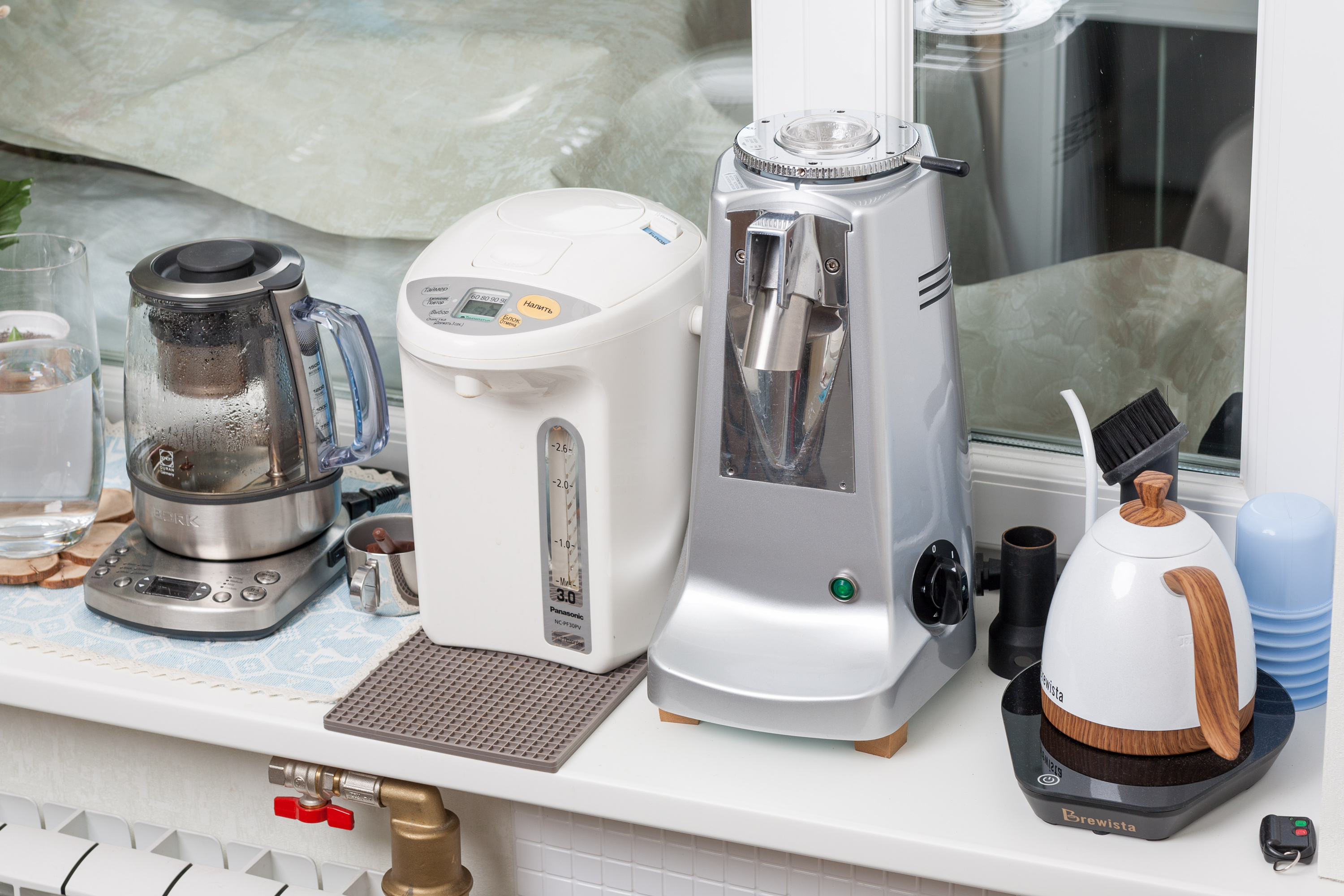Here, explain to me why dark thermopot, if there is an electric kettle? We need boiling water - 5 minutes and please.
I really love the thermo pot just because I don’t have to wait these same 5 minutes. And it's all.
And tell me he eats a lot of energy?
I have had a Panasonic NC-PF30 PVWTW thermopot for about 8 years (bought on 07/30/2010) and according to my measurements, with a mains voltage of 220V and an exposed temperature of 90 ° C, it has the following active electrical power consumption (the temperature in the room is about 23 ° C ):
- The thermo-pot is simply connected to the network, shows the temperature: 7W;
- The thermo-pot includes a heating element to slightly heat the cooled water: 107W (0.49A);
- Thermo pot understands that fresh water has been poured into it and turns on the heating mode to boil: 694W (3.14A);
In total, under my scenario of using a thermopot (adding hot water to tea or simply needing hot water), when monitored for 13 days, this gave an electricity consumption of 0.86 ± 0.06 kWh per day.
And if there are old elderly people or children at home.
In my thermo-pot (I disassembled) there is a separate mechanical thermal fuse that should disable the thermo-pot if the electronics that control the temperature fail. But here it will be as you described: all the water will boil away, since as long as there is water, the temperature of the heating element will not rise above 100 ° C.
but I looked through the whole topic and still did not understand what a thermopot is and what it looks like
Thermo pot is a thermos with a water filling system, which has a built-in heating element and electronics that can maintain the temperature you need constantly. The usage scenario is something like this: there is always water in a thermal pot, for example, 90 ° C. You walked up to it, pressed the unlock button, pressed the water pouring button and water started pouring into your cup. When there is not enough water in the thermopot, you add water to the thermopot, it boils it and then begins to maintain the temperature you set. I'm already accustomed to the fact that water should be poured into a thermopot after it was needed (unlike a kettle, where we pour water before we want to get hot water). My tea and coffee sill now looks something like this and the thermopot is the white thing between the teapot and the coffee grinder:


Now the thermopot is used only as a source of hot water, since I use other water for brewing tea and coffee than for just drinking.
Please tell me, it is believed that water boiled several times is not very useful. And in thermopots, it turns out that it is constantly boiling back and forth.
I also met the mention that water, from which the gases dissolved in it are removed, is not very useful for living organisms and people as well. If the water is hypothetically dangerous, for example, from a water supply, then it makes sense to boil it, but I have been using bottled water lately and really wanted to have in my thermostat the option not to boil water, but simply heat it to 90 ° C set by me, but something interesting I did not find any suggestions for the account (there are Redmonds in which such a thing is declared, but personally I am very confused by the reliability of the goods of this brand). On the other hand, in my Panasonic thermopot, the water does not boil for a very long time and all the gases dissolved in it do not have time to evaporate (this is evident at least by the fact that once boiled water in the thermopot will boil again, and not just evaporate intensively) ...
In other words, if a priori "safe" (for example, bottled) water is used, then perhaps it would not be bad to have the option to turn off the boiling mode at the thermopot, but personally, I still manage this way, since in my eyes the convenience of a thermopot outweighs the possible negative effects from boiled water.
In short, I share my know-how on how to heat water in a thermo-steam to the required temperature and not bring it to a boil. This can be useful for those who do not want to boil water after topping up / filling; who sets, for example, 90 degrees after 80 (in this case, the thermopot will first boil the water, and then slowly cool it down to 90) and does not want to bring the thermopot to a boil; or someone like me disconnects it from the network for the night and there remains boiled water, which you don't want to boil again the next time you turn it on.
We turn on the thermopot, select the desired temperature (for example, 80 degrees). We wait and look at the temperature sensor - how much is there now. As soon as the temperature reaches 80 degrees (if you missed it and it's already 85 - it's not scary, quickly move on) - press the timer button. Moreover, not once, but as many times as necessary to go through all its parameters and reset it to 0. The heating of the water stops and the thermopot continues to work in the mode of maintaining the set temperature. And if you missed and at the moment the temperature is higher than the selected one - as expected, the thermopot will gradually cool the contents to the selected one and will maintain it.
And it doesn't come to boiling!
Wow thanks! I didn't realize this: when the temperature reached the one I needed, I disconnected the thermo-pot from the network, by pulling the power out of it, your method is much more elegant.
From this topic I understand that probably a thermopot can replace it for us.
A thermos, in my opinion, will have better thermal insulation than a thermopot: my Panasonic Panasonic NC-PF30 PVWTW uses only an externally polished stainless bulb as thermal insulation (to reduce the amount of heat transmitted by radiation) and an air gap between the bulb and the plastic case. No more technical solutions, like a vacuum in my thermo-pot is not used. On the other hand, the larger the volume of the thermopot / thermos, the better it will keep the temperature, all other things being equal.
Who uses this miracle? Does it completely replace the kettle?
My personal opinion is that no. For example, when we drank tap water, the thermopot was used to have hot water, and the kettle was used to boil water and pour it into a decanter so that there was cold drinking water. Then they began to use bottled water and the kettle disappeared from us until the moment I got overwhelmed and I decided to use completely different water for brewing coffee / tea than for just drinking, and I got two more kettles: a teapot and a coffee kettle (with " goose nose and precise temperature control). In general, you need to think over the use cases and decide there.
microbial corpses do not bother me much (by the way, I stir sugar in tea with a silver spoon), I just think, what's the point in water, which is hot all day?
I can't answer the question, but I can say that in medicine, when "water without microbes" is required, it is kept in special autoclaves at a temperature of 200 ° C (not a typo, just two hundred), since at a lower temperature there are many different things lives quietly in the water.
I will continue to heat water for tea in the microwave, although everyone here tells me that microwaves spoil the structure of water
Water has no structure. Absolutely. For example, you can look at the Memorandum No. 2, of the RAS Commission on Combating Pseudoscience and Falsification of Scientific Research, On the Pseudoscience of Homeopathy, Appendix No. 4 On the Memory of Water:
🔗
🔗
as if boiling it doesn't make it dead
The trick here is that "dead" is not a binary concept, since there is no such thing that the water contained dissolved gases, boiled for 20 seconds and all the gases left it: they were gone, of course, but not all. And this is easy to check, for this it is enough to try to boil the water again: if there are no dissolved gases in the water, then it will not boil (bubble), but will only evaporate. For example, under vacuum, I needed at least 20 minutes of time for the main part of the dissolved gases to leave the water and it would stop boiling.
I want to get 70-75 C unboiled for brewing
Personally, I use separate kettles for this very purpose, not a thermopot.
Isn't it harmful for the device to work without interruption around the clock? Maybe he needs to "rest", to cool down?
In the case of a thermopot continuous mode, this is its main mode of operation. He doesn't even have a switch.
Attempt to heat up # 2
Thank you, the verb made me laugh.
The thermopot inside was empty
In my Panasonic, thermal insulation is done in about the same way.
For sim, I retire, so as not to embarrass those who need more thermopot than a kettle
So far it turns out that both are used
Am I the only one interested to see what's inside?
No, I also like to disassemble everything. When there is time
And I thought there would be such an option for water supply, when I pressed the button and it flows, pressed it again and stopped flowing, but it only flows as long as you hold your finger?
It's the same for me. As far as I understand, this is done for security reasons. For example, someone who worked on the press knows that to activate it, you need to press two buttons with both hands, so as not to accidentally put one under the press
And how good is the filter so that the sediment does not fall into the mug?
There is a metal mesh with relatively large holes. A suspension of sediment may well get into the cup (it does). You will need to descale the thermo-pot and everything will be fine.





